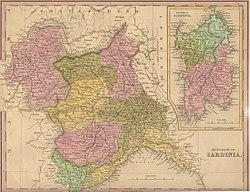This article needs additional citations for verification .(May 2025) |
This article includes a list of references, related reading, or external links, but its sources remain unclear because it lacks inline citations .(May 2025) |

The Perfect Fusion (Italian : Fusione perfetta) was the 1847 act of the Savoyard King Charles Albert of Sardinia which abolished the administrative differences between the mainland states (Savoy and Piedmont) and the island of Sardinia within the Kingdom of Sardinia, in a fashion similar to the Nueva Planta decrees between the Crown of Castile and the realms of the Crown of Aragon between 1707 and 1716 and the Acts of Union between Great Britain and Ireland in 1800.
Contents
The once-Aragonese Kingdom of Sardinia had become a possession of the House of Savoy in 1720, and it had continued to be ruled as during the era of the Spanish Empire.
Although the Sardinian people had been showing hostility against the new Piedmontese rulers since a failed insurrection in 1794, [1] [2] the island's separate status from the mainland became a problem for the local notables from the two major cities of Cagliari and Sassari [3] [4] when liberal reforms began to be put in force in Turin, and some of them started to see their own legal system as a handicap more than a privilege. A minority of other Sardinian notables, like Giovanni Battista Tuveri and Federico Fenu, were not in favour of the idea for fear that further moves toward the centralisation of the Savoy-led kingdom might follow thereafter. King Charles Albert eventually solved the problem by transforming all his dominions into a single centralized state.
A new legal system entered into force in Sardinia, and the last viceroy, Claudio Gabriele de Launay, left Cagliari on 4 March 1848. The island was divided into three provinces ruled by their prefects and followed the system that had been used in Piedmont since 1815.
The ultimate goal of the unionist movement was assimilationist, for it set about, in the words of the Pietro Martini, "to transplant, without any reserves and obstacles, the culture and civilization of the Italian Mainland to Sardinia, and thereby form a single civil family under a Father better than a King, the great Charles Albert". [5] Moreover, the fusion was supposed to spur commercial development in Sardinia and, by 1861, according to William S. Craig (the British consul-general at Cagliari), increase the kingdom's importance; [6] however, the kingdom's insular part lost what little autonomy it had previously had in the process, as well as its historical title of "nation", as it had been referred to for centuries, and illustrated by the kingdom's national anthem. In this regard, the Fusion provoked a shift in terminology, with references to "Italy" replacing "Sardinia" instead.
On the whole, the island became an even more marginal part of the Savoyard kingdom, [7] raising the so-called "Sardinian Question" pertaining to its difficult process of integration within a single national body: [8] [9] [10] [11] [12] more specifically, Sardinians lost their former powers of taxation and autonomous representation in exchange for the Piedmontese Parliament taking over legislative responsibility on the island and some seats in the Congress. [13] Most of the Sardinian unionists, including its leader Giovanni Siotto Pintor, would later come to regret it. [14] [15]
The Fusion could not improve the condition of the Sardinian notables, either. On the contrary, Sardinia's fusion into an Italian unitary state provoked, as a response, a marked increase in banditry and criminal activities against the central authorities. [16]